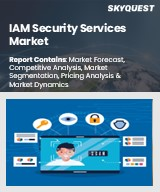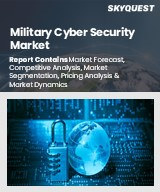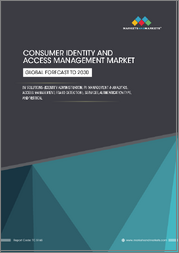
|
시장보고서
상품코드
1624533
세계의 산업용 액세스 컨트롤 시장 : 컴포넌트별, 업계별, 지역별(2024-2031년)Industrial Access Control Market By Component (Services, Software, Hardware), Vertical (Commercial, Military And Defense, Government, Manufacturing And Industrial), & Region For 2024-2031 |
||||||
산업용 액세스 제어 시장 평가, 2024-2031년
산업용 액세스 제어 시장 규모는 2023년에 104억 달러로 평가되었고, 2024년부터 2031년까지 연평균 복합 성장률(CAGR) 7.8%로 성장하며 2031년에는 162억 달러에 달할 것으로 예측됩니다. 장비의 사용이 증가하고 있는 것도 시장의 성장을 가속하는 요인이 되고 있습니다. 연결 장치의 사물 인터넷 출현, 클라우드 컴퓨팅, 블록체인 기술 등의 기술 개척은 시장에 밝은 전망을 제공하는 데 도움이 됩니다.
모바일 기기에서 생체인증을 사용하면 많은 용도의 보안 수준을 높일 수 있습니다.
산업용 액세스 제어 시장 정의/개요
산업용 액세스 제어는 부적절한 리소스에 대한 액세스를 제한하여 모든 컴퓨팅 시스템의 보안을 향상시키는 대책입니다. 데이터, 컴퓨터 네트워크를 연결하고 물리적 액세스 제어는 물리적 IT 자산, 건물 및 캠퍼스에 대한 액세스를 제한합니다.
이 솔루션의 사용에는 생체 인식 및 액세스 카드를 사용하여 본인을 확인하고 액세스를 허용하는 모든 기업과의 조합이 포함됩니다. 다양한 산업에서 널리 사용됩니다. 서비스, 소프트웨어 및 하드웨어의 세 가지로 분류됩니다.
산업용 액세스 제어 시장의 성장을 가속하는 요인은 무엇인가?
중요한 인프라와 기밀 데이터에 대한 위협의 가능성에 대한 의식이 높아짐에 따라 기업은 견고한 액세스 제어 시스템을 우선적으로 하고 있습니다. 더 안전하고 편리한 인증 방법을 제공함으로써 시장 성장에 기여하고 있습니다.
또한 각 업계의 엄격한 규제 요건과 규정 준수 기준은 기업이 불법 액세스 및 잠재적 침해를 방지하기 위해 고급 입퇴실 관리 시스템에 투자하도록 촉구하고 있습니다.
또한 인더스트리 4.0의 원칙이 받아들여지고 산업 환경에서 IoT 장치가 널리 사용됨에 따라 네트워크 시스템을 보호하는 종합적인 액세스 제어 메커니즘의 중요성이 부각되었습니다. 기업은 보안 위협을 제거하고 업무를 보장하기 위해 액세스 제어의 중요한 역할을 점점 더 인식하고 있습니다.
산업용 액세스 컨트롤 시장의 매출을 급락시키고 있는 요인은?
산업용 액세스 제어 시장은 성장 궤도에 영향을 미치는 다양한 변수로 인해 판매가 줄어들고 있습니다. 특히 산업 부문에서는 많은 기업이 재정난에 빠져 있으며, 그 결과 새로운 인프라 프로젝트와 개축이 늦어지고 있습니다.
COVID-19의 발생은 공급망을 혼란시키고 건축을 늦추고 산업용 액세스 제어 솔루션 수요를 줄였습니다. 시대에 뒤떨어지면서 구매 희망자는 보다 정교하고 종합적인 솔루션을 찾고 구매를 앞당기고 있습니다.
산업용 입퇴실 관리 시장에서 매출을 늘리려면 업계 각사가 변화하는 시장 역학에 적응하고, 참신한 솔루션을 제공하고, 현재의 경제 시나리오가 제기하는 특정 우려에 대답해야 할 수도 있습니다.
목차
제1장 산업용 액세스 컨트롤 세계 시장 : 소개
- 시장의 소개
- 조사 범위
- 전제조건
제2장 주요 요약
제3장 VERIFIED MARKET RESEARCH의 조사 방법
- 데이터 마이닝
- 밸리데이션
- 1차 자료
- 데이터 소스 일람
제4장 산업용 액세스 컨트롤 세계 시장 전망
- 개요
- 시장 역학
- 성장 촉진요인
- 억제요인
- 기회
- Porter's Five Forces 모델
- 밸류체인 분석
- 규제 프레임워크
제5장 산업용 액세스 컨트롤 세계 시장 : 컴포넌트별
- 개요
- 서비스
- 전문 서비스
- 시스템 통합 및 설치
- 보안 컨설팅
- 지원 및 유지 보수
- 관리 서비스
- 소프트웨어
- 통합 액세스 제어 소프트웨어
- 독립형 소프트웨어/미들웨어
- 바이오메트릭 소프트웨어
- 기타
- 하드웨어
- 지문 스캐너
- 얼굴 인식 장치
- 홍채 스캐너
- 스마트 카드
- 기타
제6장 산업용 액세스 컨트롤 세계 시장 : 업계별
- 개요
- 상업
- 주택
- 군 및 방위
- 정부기관
- 제조업 및 공업
- 운수
- 기타
제7장 산업용 액세스 컨트롤 세계 시장 : 지역별
- 개요
- 북미
- 미국
- 캐나다
- 멕시코
- 유럽
- 독일
- 영국
- 프랑스
- 기타 유럽
- 아시아태평양
- 중국
- 일본
- 인도
- 기타 아시아태평양
- 라틴아메리카
- 브라질
- 아르헨티나
- 중동 및 아프리카
- 남아프리카
- 사우디아라비아
- 아랍에미리트(UAE)
제8장 산업용 액세스 컨트롤 세계 시장 경쟁 구도
- 개요
- 기업별 시장 점유율
- 벤더 상황
- 주요 발전 전략
제9장 기업 프로파일
- Honeywell International
- Bosch
- Siemens
- Matrix Comsec
- HID Global
- Echelon
- BioEnable Technologies
- Paxton Access
- Assa Abloy
- NEC Corporation
제12장 부록
- 관련 조사
Industrial Access Control Market Valuation - 2024-2031
Industrial Access Control Market size was valued at USD 10.4 Billion in 2023 and is projected to reach USD 16.20 Billion by 2031, growing at a CAGR of 7.8% from 2024 to 2031. Growing concern for data security and rising cyber threats are the major factors driving the growth of the market. Increasing use of wireless technology and electronic devices is another factor driving the growth of the market. In addition, technological developments such as the emergence of the Internet of Things for connected devices, cloud computing and blockchain technology help provide a positive outlook for the market. The lack of awareness of security solutions and their high cost can be a limitation of the market.
The use of biometrics in mobile devices raises the security bar for many applications. Smartphones that support biometrics are evaluated as a new and complementary platform that expands the authentication technology market and improves user convenience and security.
Industrial Access Control Market: Definition/Overview
Industrial Access Control is a measure that improves the security of any computing system by limiting access to illegal resources. It comprises both logical and physical access. Logical access control connects system files, data, and computer networks, whereas physical access control restricts access to physical IT assets, buildings, and campuses.
The applications of this solution includes verifying the person's identification using biometrics or access cards, as well as verifying the same with any corporate entities to grant access. It is widely used in a variety of industries, including commercial, military and defense, government, manufacturing and industrial, transportation, and others. They are divided into three categories based on the component: services, software, and hardware.
What's inside a VMR industry report?
Our reports include actionable data and forward-looking analysis that help you craft pitches, create business plans, build presentations and write proposals.
What Factors are Driving the Growth of the Industrial Access Control Market?
The growing awareness of possible threats to key infrastructure and sensitive data has prompted enterprises to prioritize strong access control systems. The rising incorporation of modern technologies such as biometrics, smart cards, and facial recognition contributes to the market's growth by providing more secure and convenient authentication methods.
Also, severe regulatory requirements and compliance standards across industries encourage firms to invest in sophisticated access control systems to prevent illegal access and potential breaches.
Furthermore, the growing acceptance of Industry 4.0 principles and the widespread use of IoT devices in industrial environments highlight the significance of comprehensive access control mechanisms in protecting networked systems. Businesses increasingly realize the critical role of access control in eliminating security threats and assuring operations.
What Factors are Plummeting Sales of the Industrial Access Control Market?
The Industrial Access Control Market has seen a decrease in sales due to a variety of variables influencing its growth trajectory. One important cause is the economic downturn and uncertainty that have affected industry around the world. Many enterprises, notably in the industrial sector, have had financial difficulties, resulting in a delay in new infrastructure projects and renovations.
The COVID-19 outbreak has disrupted supply chains and slowed building, reducing demand for industrial access control solutions. Furthermore, technical improvements and changing threat landscapes have rendered previous access control systems obsolete, causing prospective buyers to postpone purchases in favor of more advanced and comprehensive solutions.
To boost sales in the Industrial Access Control Market, industry players may need to adapt to changing market dynamics, provide novel solutions, and answer specific concerns raised by the present economic scenario.
Category-Wise Acumens
Which Component Category Holds the Dominant Market Share in the Industrial Access Control Market?
Biometric readers in the hardware segment have become the dominant force in the field of industrial access control, holding a sizable market share. The increasing focus on improving security protocols in industrial environments has propelled the acceptance of biometric technology because of its unmatched precision and dependability. Biometric readers provide a better level of security than traditional access control techniques like keycards or PIN codes because they use distinctive physiological or behavioral traits like fingerprints, face features, or iris patterns for authentication.
The reason biometric readers are so widely used is because they offer reliable and easy-to-use access control solutions. Biometrics have many built-in benefits, such as resistance to identity theft and non-repudiation, which make them perfect for protecting sensitive industrial environments.
Biometric readers are preferred by sectors with high levels of security concerns, like manufacturing plants, research facilities, and vital infrastructure locations, since they can create a strong, impenetrable access control system. The efficiency of biometric readers in preventing unwanted access and guaranteeing the general safety of industrial facilities is further enhanced by their integration with other security systems and technologies. The dominance of biometric readers in the hardware segment is expected to continue and maybe grow as long as security is prioritized in the industrial environment. This will spur innovation and help to shape the future of industrial access control solutions.
How Commercial Segment is Contributing the Largest Revenue Share in Industrial Access Control Market?
Businesses and enterprises in various industries place importance on implementing robust access control systems to protect their facilities, assets and confidential information. The commercial sector includes a wide range of establishments, including office buildings, shopping centers and financial institutions, all of which require strong access control. The need for secure and efficient solutions to manage employee access, guest access and overall building security is important in the commercial sector and is driving high demand for control technology. enter.
As businesses continue to embrace digital transformation, growth is accelerating. Rely on advanced access control solutions that integrate with other business systems to improve operational efficiency. The commercial sector's efforts to ensure compliance with industry regulations and protection against unauthorized access are increasingly adopting access control systems. Growing awareness of cyber threats and the need for comprehensive security measures are increasing the demand for access control solutions in commercial environments.
Country/Region Wise Acumens
Could North America Drive an Increase in Sales within the Industrial Access Control Market?
North America has the potential to considerably boost sales in the Industrial Access Control Market. The region's substantial industrial sector, which includes manufacturing, energy, and infrastructure, drives a high demand for innovative security solutions.
Industries are investing heavily in cutting-edge access control technology as the need of protecting key assets and data becomes more widely recognized. North American businesses are particularly likely to utilize sophisticated and integrated access control systems to improve overall security measures.
Severe laws and compliance standards in industries such as healthcare, banking, and defense drive the adoption of industrial access control systems. As enterprises emphasize the safety of persons, facilities, and sensitive information, the market for access control systems is positioned to grow significantly in North America.
Will the Industrial Access Control Market's Dominance continue in Asia Pacific?
Asia Pacific's Industrial Access Control Market has grown significantly in recent years due to the region's growing industrial sector and rising awareness of the value of strong security measures. The necessity for stricter safety measures, growing worries about unwanted entry, and technological developments have all contributed to the increased use of access control systems.
The demand for industrial access control systems has increased as a result of investments made by Asia Pacific nations, especially rising economies, in manufacturing facilities, smart technologies, and infrastructure development. Furthermore, the use of advanced access control solutions in a variety of industrial settings can be attributed to the increased focus on adhering to safety norms and laws.
Forecasting the Industrial Access Control Market's sustained dominance in Asia Pacific is contingent upon a number of dynamic elements, such as developments in technology, regulations, and economic trends. For the most recent information on the present state and anticipated future growth of the Industrial Access Control Market in the Asia Pacific region, it is recommended that one peruse the most recent market studies and industry analyses.
Competitive Landscape
The competitive landscape of the Industrial Access Control Market is characterized by the presence of several key players and a mix of large multinational companies, regional players, and niche solution providers. Companies such as Honeywell, Bosch Security Systems, and Johnson Controls, dominate the market with their extensive product portfolios and global presence. These established players leverage their brand reputation, technological expertise, and strong customer relationships to maintain a competitive edge.
Some of the prominent players operating in the Industrial Access Control Market include:
Honeywell International, Bosch, Siemens, Matrix Comsec, HID Global, Echelon, BioEnable Technologies, Paxton Access, Assa Abloy, NEC Corporation, 3M, Johnson Controls, Thales Group, Dormakaba Holding, Identiv, STANLEY Convergent Security Solutions, Secom, Allegion, Brivo, Adman Technologies, Vanderbilt Industries, Access Control Innovation, Openpath, and Ava Security.
Latest Developments
In March 2023, Axis Communications and Genetec Inc. partnered to launch Axis, an enterprise-level access control solution that combines Genetec access control software and Axis network door controllers in a single, easy-to-deploy package. This solution is the first of its kind on the market and utilizes Genetec technology to provide unified security, public safety, operations, and business intelligence solutions.
In February 2023, Air Canada announced a new digital facial recognition pilot program for selected flights between Vancouver and Winnipeg, as well as for qualified customers at the Air Canada Cafe at Toronto Pearson International Airport. The airline claims to be the first in Canada to offer this technology to its customers. The program aims to streamline the boarding process, reduce wait times, and increase efficiency. Air Canada plans to eventually extend this service to a few Canadian airports and Maple Leaf Lounges.
TABLE OF CONTENTS
1 INTRODUCTION OF GLOBAL INDUSTRIAL ACCESS CONTROL MARKET
- 1.1 Introduction of the Market
- 1.2 Scope of Report
- 1.3 Assumptions
2 EXECUTIVE SUMMARY
3 RESEARCH METHODOLOGY OF VERIFIED MARKET RESEARCH
- 3.1 Data Mining
- 3.2 Validation
- 3.3 Primary Interviews
- 3.4 List of Data Sources
4 GLOBAL INDUSTRIAL ACCESS CONTROL MARKET OUTLOOK
- 4.1 Overview
- 4.2 Market Dynamics
- 4.2.1 Drivers
- 4.2.2 Restraints
- 4.2.3 Opportunities
- 4.3 Porters Five Force Model
- 4.4 Value Chain Analysis
- 4.5 Regulatory Framework
5 Global Industrial Access Control Market, By Component
- 5.1 Overview
- 5.2 Services
- 5.2.1 Professional Services
- 5.2.2 System Integration & Installation
- 5.2.3 Security Consulting
- 5.2.4 Support & Maintenance
- 5.2.5 Managed Services
- 5.3 Software
- 5.3.1 Integrated Access Control Software
- 5.3.2 Standalone Software/Middleware
- 5.3.3 Biometric Software
- 5.3.4 Others
- 5.4 Hardware
- 5.4.1 Fingerprint Scanners
- 5.4.2 Facial Recognition Devices
- 5.4.3 Iris Scanners
- 5.4.4 Smart Cards
- 5.4.5 Others
6 Global Industrial Access Control Market, By Vertical
- 6.1 Overview
- 6.2 Commercial
- 6.3 Residential
- 6.4 Military and Defense
- 6.5 Government
- 6.6 Manufacturing and Industrial
- 6.7 Transportation
- 6.8 Others
7 GLOBAL INDUSTRIAL ACCESS CONTROL MARKET, BY GEOGRAPHY
- 7.1 Overview
- 7.2 North America
- 7.2.1 U.S.
- 7.2.2 Canada
- 7.2.3 Mexico
- 7.3 Europe
- 7.3.1 Germany
- 7.3.2 U.K.
- 7.3.3 France
- 7.3.4 Rest of Europe
- 7.4 Asia Pacific
- 7.4.1 China
- 7.4.2 Japan
- 7.4.3 India
- 7.4.4 Rest of Asia Pacific
- 7.5 Latin America
- 7.5.1 Brazil
- 7.5.2 Argentina
- 7.6 Middle East and Africa
- 7.6.1 South Africa
- 7.6.2 Saudi Arabia
- 7.6.. UAE
8 GLOBAL INDUSTRIAL ACCESS CONTROL MARKET COMPETITIVE LANDSCAPE
- 8.1 Overview
- 8.2 Company Market Share
- 8.3 Vendor Landscape
- 8.4 Key Development Strategies
9 COMPANY PROFILES
- 9.1 Honeywell International
- 9.1.1 Overview
- 9.1.2 Financial Performance
- 9.1.3 Product Outlook
- 9.1.4 Key Developments
- 9.2 Bosch
- 9.2.1 Overview
- 9.2.2 Financial Performance
- 9.2.3 Product Outlook
- 9.2.4 Key Developments
- 9.3 Siemens
- 9.3.1 Overview
- 9.3.2 Financial Performance
- 9.3.3 Product Outlook
- 9.3.4 Key Developments
- 9.4 Matrix Comsec
- 9.4.1 Overview
- 9.4.2 Financial Performance
- 9.4.3 Product Outlook
- 9.4.4 Key Developments
- 9.5 HID Global
- 9.5.1 Overview
- 9.5.2 Financial Performance
- 9.5.3 Product Outlook
- 9.5.4 Key Developments
- 9.6 Echelon
- 9.6.1 Overview
- 9.6.2 Financial Performance
- 9.6.3 Product Outlook
- 9.6.4 Key Developments
- 9.7 BioEnable Technologies
- 9.7.1 Overview
- 9.7.2 Financial Performance
- 9.7.3 Product Outlook
- 9.7.4 Key Developments
- 9.8 Paxton Access
- 9.8.1 Overview
- 9.8.2 Financial Performance
- 9.8.3 Product Outlook
- 9.8.4 Key Developments
- 9.9 Assa Abloy
- 9.9.1 Overview
- 9.9.2 Financial Performance
- 9.9.3 Product Outlook
- 9.9.4 Key Developments
- 9.10 NEC Corporation
- 9.10.1 Overview
- 9.10.2 Financial Performance
- 9.10.3 Product Outlook
- 9.10.4 Key Developments
12 Appendix
- 12.1 Related Research



















